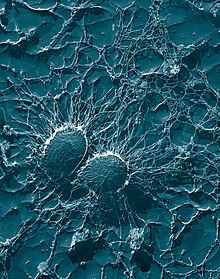
Coagulase is a protein enzyme produced by several microorganisms that enables the conversion of fibrinogen to fibrin. In the laboratory, it is used to distinguish between different types of Staphylococcus isolates. Importantly, S. aureus is generally coagulase-positive, meaning that a positive coagulase test would indicate the presence of S. aureus or any of the other 11 coagulase-positive Staphylococci.[1] A negative coagulase test would instead show the presence of coagulase-negative organisms such as S. epidermidis or S. saprophyticus. However, it is now known that not all S. aureus are coagulase-positive.[2][3] Whereas coagulase-positive staphylococci are usually pathogenic, coagulase-negative staphylococci are more often associated with opportunistic infection.[4]
It is also produced by Yersinia pestis.[5]
Coagulase reacts with prothrombin in the blood. The resulting complex is called staphylothrombin, which enables the enzyme to act as a protease to convert fibrinogen, a plasma protein produced by the liver, to fibrin. This results in clotting of the blood. Coagulase is tightly bound to the surface of the bacterium S. aureus and can coat its surface with fibrin upon contact with blood. The fibrin clot may protect the bacterium from phagocytosis and isolate it from other defenses of the host.[6] The fibrin coat can therefore make the bacteria more virulent. Bound coagulase is part of the larger family of MSCRAMM adhesin proteins.
- ^ Becker et al., 2014. PMID 25278577
- ^ Ryan KJ, Ray CG (editors) (2004). Sherris Medical Microbiology (4th ed.). McGraw Hill. ISBN 0-8385-8529-9.
- ^ PreTest, Surgery, 12th ed., p.88
- ^ González-Martín M, Suárez-Bonnet A, Tejedor-Junco MT (2020). "Virulence factors in coagulase-positive staphylococci of veterinary interest other than Staphylococcus aureus". Veterinary Quarterly. 40 (1): 118–131. doi:10.1080/01652176.2020.1748253. PMC 7178840. PMID 32223696.
- ^ "coagulase" at Dorland's Medical Dictionary
- ^ Tortora, Gerard J.; Funke, Berdell R.; Case, Christine L. (2013). Microbiology: An Introduction (11 ed.). Glenview, IL: Pearson Education Inc. p. 434. ISBN 978-0-321-73360-3.